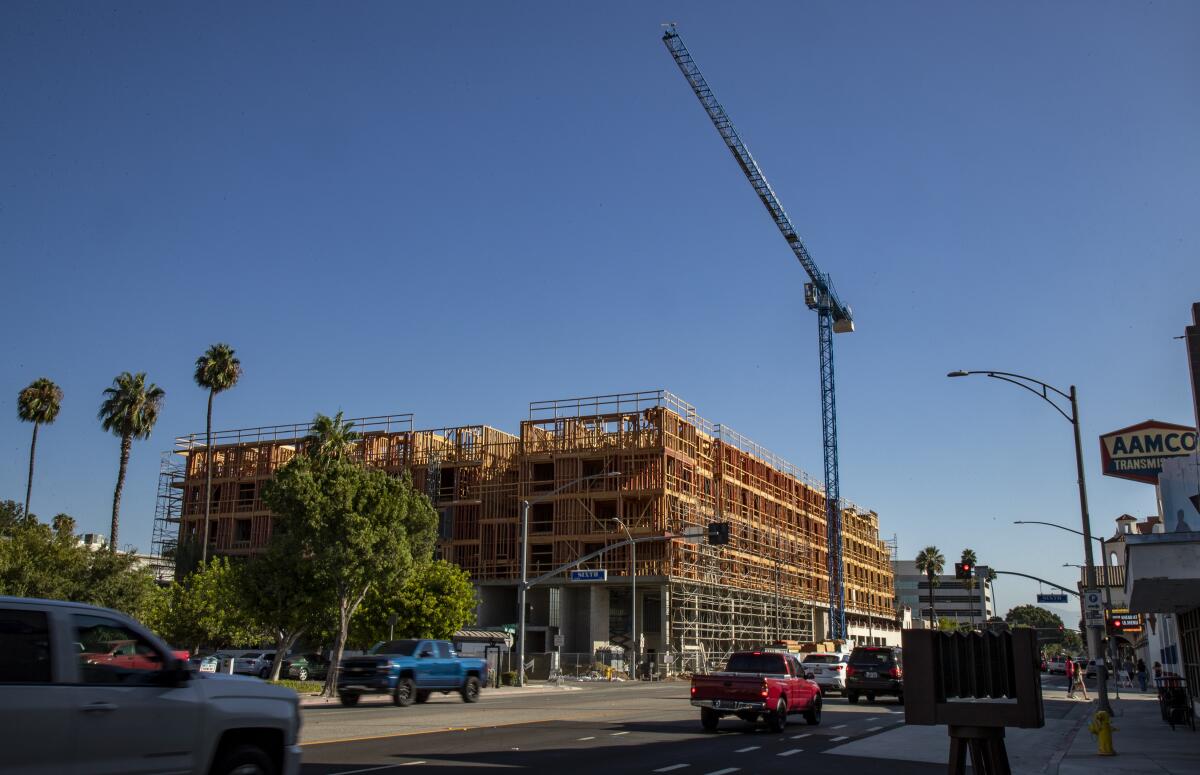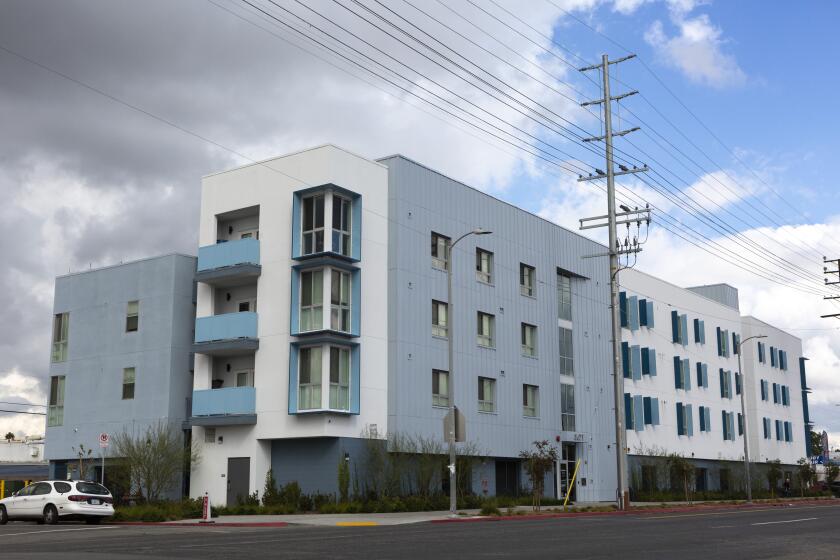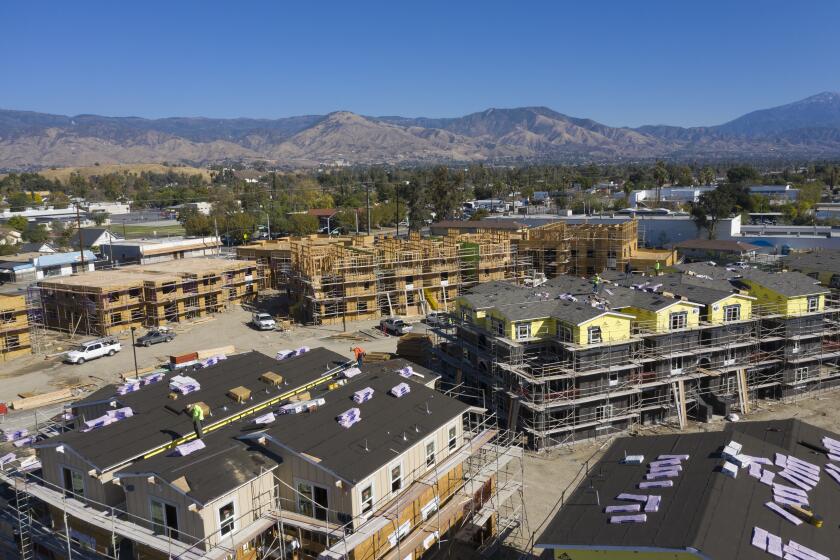Editorial: California needs more housing and good jobs. There’s a bill to create both

- Share via
What if California could encourage developers to replace shuttered big-box stores, half-vacant offices and decrepit strip malls with apartments, condominiums and townhomes, with some or even all of the units being affordable? And what if the construction workers building those projects were paid union-level wages and, in some cases, received healthcare, thus creating lots of good-paying jobs.
It sounds like a win-win, right?
It should be. But in California — despite a housing shortage that has driven up home prices and rents to vastly unaffordable levels — politics and interest groups can often torpedo even the most common-sense compromises.
So, if you care about solving the housing crisis and want California lawmakers to put the interests of the whole state over the demands of the few, then keep your eye on Assembly Bill 2011 by Assemblymember Buffy Wicks (D-Oakland).
It’s beyond exasperating that a state Senate bill to create a housing agency to fund affordable housing did not get passed last year.
The proposal developed by affordable-housing developers and the carpenters union would streamline approvals for certain housing developments in commercially zoned areas and set new labor standards for construction workers. And, most importantly, it would end a political standoff over requiring union labor to build privately funded housing that has killed good housing bills for the last three years.
The powerful State Building and Construction Trades Council, which represents 450,000 plumbers, roofers, pipe fitters and other skilled laborers, has opposed bills to streamline housing approvals unless developers guaranteed that at least one-third of construction workers on the projects would be graduates of apprenticeship programs — most of whom are union members.
The California Housing Consortium, an affordable-housing group, has warned that the “skilled and trained workforce” mandate is difficult to manage and could halt construction in areas short of union labor. That’s a real concern; only about 1 in 6 workers in the construction industry would qualify as “skilled and trained,” according to the carpenters union analysis, and most of them are building public and private infrastructure projects. Most private sector home-building is done by nonunion workers, who often make near-poverty pay. Wage theft is rampant. No wonder there is a shortage of laborers to build homes.
What’s different this year is that the developers and the California Conference of Carpenters have come up with a middle-ground approach, recognizing that the state needs to ramp up housing construction now and it may take longer to expand the skilled union workforce.
Lawmakers have allowed a political standoff with labor to stall bills to build more homes, including affordable ones.
Under AB 2011, construction workers would be paid union-level prevailing wages with new enforcement measures to cut down on wage theft. In projects with 50 or more units, the developer would pay for health benefits and would have to request the dispatch of apprentices. If no apprentices are available, the developer could still build.
The trades council opposes the bill, arguing that its labor standards have loopholes and that the best way to protect workers and improve their livelihood is to require skilled and trained union members. The trades council carries enormous sway in the labor-friendly Legislature. But other labor groups have waded in as well on the side of AB 2011. The state’s Service Employees International Union and the union representing school custodians, cafeteria and other classified workers support the bill because their members desperately want more affordable housing.
AB 2011 is a vast improvement over the status quo, and not just for workers.
Most cities in California prohibit residential development in commercial zones. The shift to online shopping and remote work has left some retail and offices underused, and there’s an opportunity to convert aging strip malls, big-box stores, parking lots and offices into homes. Peter Calthorpe, the Berkeley-based urban planner, analyzed underutilized low-density commercial properties in Los Angeles County and estimated the land could accommodate 1.6 million housing units.
AB 2011 would override local zoning to allow 100% affordable housing developments on properties zoned for commercial, office and parking. Mixed-income housing would be limited to properties on four-to-six-lane commercial corridors and must include at least 15% affordable units. The projects would have to meet objective design standards and go through city review for building quality, health and safety. But they wouldn’t need city council approval and would be exempt from California Environmental Quality Act studies and lawsuits.
Advocates need money to fund a campaign to repeal a provision in California’s Constitution that makes it harder to build affordable housing.
The bill still needs some work. Los Angeles is one of the few cities in the state that already allows residential development in commercial zones, and the city’s successful incentive programs require that 20% to 25% of the new units be affordable — which is more stringent than AB 2011. In a letter, L.A. Mayor Eric Garcetti said he supports the bill but asked that it not preempt existing affordable housing programs.
His office also raised concerns about permitting residential construction next to industrially zoned lands. That’s a recipe for environmental injustice if truck yards, factories or other polluting facilities can be built next to homes.
Lawmakers have an opportunity to address two of the state’s most challenging problems. California can encourage the development of a lot more homes in commercial centers that are often more walkable and near transit and avoid some of the complaints about densifying single-family neighborhoods. And the state can help create a lot more construction jobs with good pay, working conditions and benefits, which means the people building the homes can afford to live in them. Take the win-win and pass AB 2011.
More to Read
A cure for the common opinion
Get thought-provoking perspectives with our weekly newsletter.
You may occasionally receive promotional content from the Los Angeles Times.













